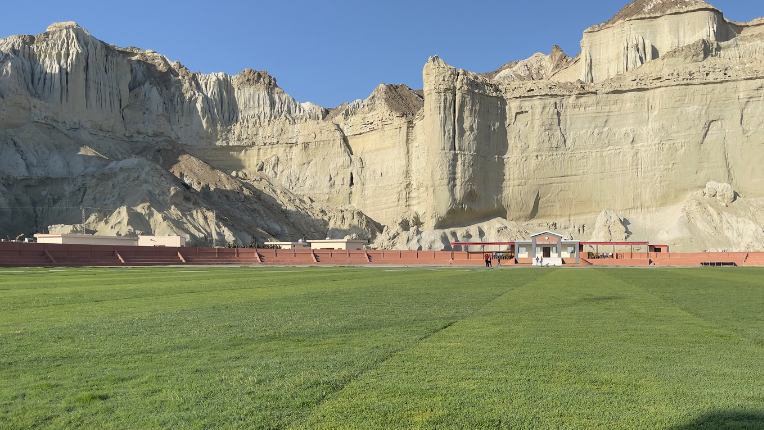Pakistan’s off-field cricket triumph
Regardless of how well Pakistan’s cricket team has done on the field, the 2025 Champions Trophy is a national triumph, writes Ali Khan. After almost three decades of isolation driven by security fears, Pakistan once again plays host to a major international tournament, providing a beleaguered society a much-needed boost.
2 March 2025

It was a grey morning in March 2009 in Lahore when the news broke. The Sri Lankan cricket team bus had been attacked enroute the Gaddafi stadium by armed terrorists. There were casualties and some of the Sri Lankan cricketers had sustained serious injuries. The attack was the final nail in a coffin that had already seen many teams refuse to tour Pakistan from the early 2000s following a declining security situation in the wake of the September 11 attacks and the subsequent ‘War on Terror’.
Following the 2009 attack the isolation became complete. Between 2009 and 2019, save for a short tour by Zimbabwe in 2015, there was no international cricket in Pakistan. A generational drought of cricket followed for both fans and the cricketers. Entire careers have been completed without a home game. Azhar Ali, Pakistan’s 5th highest ever Test Match run getter played 7 of his 97 test matches at home. Misbah ul Haq, one of Pakistan’s most successful captains played 5 Tests at home in a career spanning 75 matches.
This is why the International Cricket Council (ICC) 2025 Champions Trophy – played in the One Day International (ODI), 50-over, format – is so important. Pakistan is hosting 15 matches at home between 19 February and 9 March, including with Australia. The last international ICC tournament held in the country dates back almost 30 years to 1996. It provides a vital fillip to the national spirit at a time when Pakistan is beset by all manner of economic and political challenges.
Prior to 2000 Pakistan had been a regular destination for international tours and it had co-hosted the 1987 and 1996 World Cups, with 1996 final being held in Lahore. Even in squash and hockey , sports which Pakistan had dominated until the 1990s, the country was a regular part of the international circuit. The Hockey Champions Trophy, which attracted the top international teams, was held 11 times in Pakistan between its inception in 1978 and 2004. A Hockey World Cup was also held in Lahore. The Pakistan Open was a regular feature of the squash circuit and featured the best players from across the globe.
The sporting isolation from 2009 had an enormous impact on the morale of the country. For all the tribulations that were faced by ordinary Pakistanis there had always been the refuge of cricket. That too had been snatched away.
A measure of the importance the government attaches to the Champions Trophy is that Mohsin Naqvi, the current Minister of Interior, was elected Chairman of the Pakistan Cricket Board (PCB) on the eve of the tournament to ensure all went smoothly. Just as 2009 represented an absolute break from international cricket, 2025 represents an almost complete rehabilitation, whatever the woes of the national team in the competition itself.
It is fair to say ‘almost complete rehabilitation’ because the tournament hasn’t been without its geopolitical controversy. India refused to tour Pakistan, instead insisting on playing all its games being in Dubai, citing security and political tensions. It was the only team not to come to Pakistan.
Having visited India for the 2023 World Cup, and having agreed to play in Gujrat, Pakistan expected India would reciprocate for the Champions Trophy. Instead, the Board for Control of Cricket India (BCCI) informed the ICC in mid-November, three months prior to the start of the tournament, of the refusal to tour Pakistan. It is worth remembering that the ICC had awarded the tournament to Pakistan in November 2021. The late refusal by India threw the entire tournament into doubt and delayed the announcement of the final schedule to the end of 2024, making logistics for travel from abroad almost impossible.
India’s commercial clout meant that a tournament without them would have been unviable for broadcasters forcing the implementation of an alternate ‘compromise’ hybrid model. There were also serious concerns over whether Pakistan would even be ready to host the event considering its two largest stadiums in Lahore and Karachi were undergoing significant renovation. To their credit, the PCB managed to upgrade both stadiums within four months, in time for the opening matches.
Despite controversy in the run up to the tournament, once it has started the overwhelming feeling among fans was joy. In her book, The New Pakistani Middle Class, Ammara Maqsood argues: “Most Pakistanis are painfully aware of how they are viewed by the world outside; they are perceived as a country of terrorists or, at best, backward religious zealots.” Correcting this misconception is important to Pakistanis alongside the feeling that they are no longer outcasts.
In 2004, when India toured Pakistan after a gap of over a decade, the chairman of the PCB had been adamant that one of the objectives of the tour was to show that Pakistanis were not what the outside world had made them out to be. Two decades later, cricket again is being used to help define Pakistan’s international personality. At every match venue, banners eagerly welcome the teams, entreating the outside world to see Pakistan as a safe and hospitable country, and one that is keen to be part of the comity of nations.
For the past decade, the globalisation of televised cricket coverage has meant that Pakistani fans have become familiar with international cricketers, particularly through the franchise-based leagues such as the Indian Premier League and the Australian Big Bash. While the interaction has been at a distance, individual players and teams have built up significant followings in Pakistan.
Without a doubt one of the highlights of the tournament thus far has been the match between England and Australia in Lahore. Rain a day earlier had cleared the atmosphere of a city that is regularly among the most polluted in the world. Clear blue skies and mild temperatures greeted the teams. The newly renovated Gaddafi stadium rapidly filled to its 34,000 capacity and, while both teams had support, there was little doubt that Australia’s dynamic all-rounder Glen Maxwell was the crowd. Lahore was enthralled by the oldest rivalry in cricket and the electric atmosphere was marked by an unbridled joy at watching two wonderful teams play out a nail-biting match in their city.
There have been some other extraordinary moments; none greater than cricketing minnow Afghanistan’s stunning win over England on Wednesday. Still, all the matches have generated local interest as Pakistanis have rallied behind Buttler, Klaasen, Smith, and Rashid Khan among others. Fans have been seen wearing the blue number 18 shirt of Indian batsman Virat Kohli, indicative of the strong fan base Indian cricket has within Pakistan. There is little doubt that the Indian team would have been warmly welcomed and would have attracted the largest crowds.
There has been very little cheer in Pakistan in the past few years. Deadly floods killed thousands and caused upward of $40 billion in damages in 2022. A withering economic and political crisis followed. But the return of cricket is one of the shining lights in the deepening gloom. For the first time in almost 30 years, Pakistani crowds have cheered wildly for an Australian, or an Englishman or an Afghan. The multicultural nature of the event has helped reintegrate Pakistan with the wider cricketing fraternity.
Pakistan fans might be disappointed with a lacklustre on-field performance that forced their team out of the competition. But they can celebrate a greater triumph: Pakistan performing as part of a wider global community. The Champions Trophy will be one of Pakistan’s most important cultural events of the 21st century, a long-awaited opportunity to open its doors internationally and show that it belongs on a global stage.
Ali Khan is Professor of Anthropology at the Mushtaq Ahmad School of Humanities and Social Sciences at LUMS in Lahore. He is author of “Cricket in Pakistan: Nation, Identity and Politics”, Oxford University Press, 2022.
How can we help? Get in touch to discuss how we can help you engage with Asia
